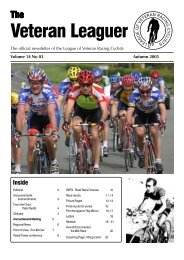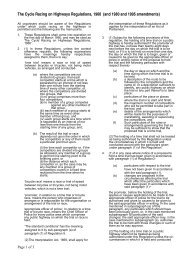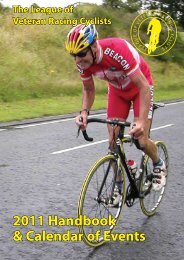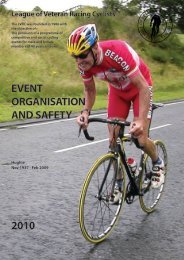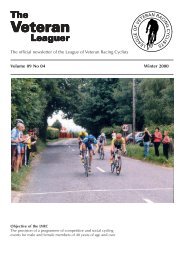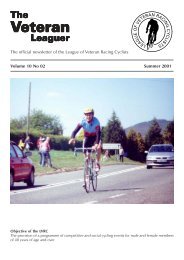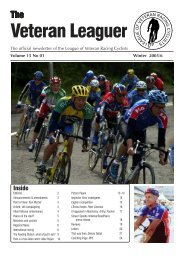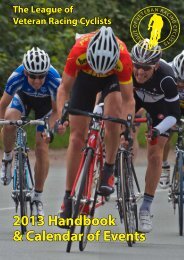You also want an ePaper? Increase the reach of your titles
YUMPU automatically turns print PDFs into web optimized ePapers that Google loves.
The Feeding Station<br />
Are you getting enough CHO?<br />
UP UNTIL THE 1980S cyclists were so<br />
ignorant about nutrition that rare steak<br />
was the standard pre-race meal for all<br />
road-racing cyclists. Silly, really,because<br />
the vital importance of carbohydrate<br />
(CHO) had been demonstrated back in<br />
1939. Cyclists fed a low CHO diet took<br />
60 minutes to ride to exhaustion on an<br />
exercise bike; those on a normal mixed<br />
diet took 1 hr 44min; those on high<br />
CHO took 2hr 50min. Carbohydrate is<br />
the one sure, legal, performanceenhancing<br />
aid that really works.<br />
Carbohydrate is stored as glycogen in<br />
the liver and muscles, along with three<br />
times its own weight in water; but your<br />
body is able to store very little – perhaps<br />
2000 kCal. However you exercise, you<br />
will use a certain amount of glycogen,<br />
and the amount in your muscles will<br />
dictate how long and hard you can<br />
exercise.<br />
You should therefore begin any<br />
exercise with high glycogen stores. You’ll<br />
use it up according to the intensity and<br />
duration of the exercise. The higher the<br />
intensity, and/or the longer the duration,<br />
the more you’ll use. Clearly, if you’re<br />
taking part in a strenuous, lengthy<br />
Fruit & Nut<br />
Porridge<br />
50 gm (2 oz) porridge oats<br />
400 ml skimmed milk<br />
25 gm (1 oz) raisins or mixed dried fruit<br />
1 medium banana, chopped<br />
15 gm chopped mixed nuts<br />
Sprinkle of cinnamon<br />
Preparation time: 5 minutes<br />
exercise like road racing (or hard<br />
training), you will have to refuel. The<br />
higher your CHO intake, the faster you<br />
can replenish your glycogen stores. This<br />
is particularly important if you train daily,<br />
or are riding a stage race. If your food is<br />
low in CHO you will take much longer to<br />
replenish your glycogen than if it is high<br />
in CHO. Unless you replace what you<br />
used, the next day you will fatigue earlier<br />
and achieve smaller training gains.<br />
Sometimes you will need a rest day in<br />
order to achieve this. However, a trained<br />
athlete is able to store more glycogen<br />
than an untrained one.<br />
You should therefore base all your<br />
meals on foods high in CHO. Choose<br />
the CHO (bread, pasta, potatoes, rice)<br />
first, and then decide what to have with<br />
it.<br />
Immediately following strenuous<br />
exercise the body is particularly ready to<br />
take on CHO. In this period muscle<br />
glycogen manufacture increases from a<br />
normal 5% to 8%. So you should start<br />
refuelling immediately after exercise.<br />
Don’t wait. You should aim at eating at<br />
least 1 gm CHO per kilo bodyweight. If<br />
you weigh 70 kg, that’s 70 gms. Start<br />
Cooking time: 5 minutes<br />
1.Mix the oats and milk and cook in a microwave (about 3 minutes,<br />
stirring twice during cooking time) or in a saucepan (about 5–6<br />
minutes, stirring continuously).<br />
2. When oats are cooked, add raisins, bananas and nuts and stir.<br />
3. Add extra milk or water as desired and warm slightly if necessary.<br />
4. Turn into serving dish and sprinkle with cinnamon.<br />
Serve with low-fat natural yoghurt or fromage frais<br />
Nutrition per serving 315 kCal; 12 gm protein, 8 gm fat, 53 gm<br />
carbohydrate.Ideal breakfast before training, a snack after training,<br />
or a dessert. Moderate source of calcium.<br />
with a whole bottle of your favourite<br />
carbo fuel, 50 gm dissolved in water, plus<br />
a banana sandwich. Then you need to<br />
eat at least 50 gm of CHO per two hours<br />
– more if possible. Don’t leave long gaps<br />
– it will slow down the rate of recovery.<br />
Grazing, eating little and often, is a much<br />
more efficient way of feeding than is<br />
eating one or two large meals.<br />
Many people think that eating sugary<br />
foods before exercise will trigger a surge<br />
of insulin and low blood sugar. This is<br />
not the case. Eating a banana (or even<br />
two) immediately before a race will<br />
improve your endurance.<br />
Taking on CHO during exercise of an<br />
hour or more is also beneficial, even in a<br />
25-mile time-trial. What’s more, it’s been<br />
shown that you recover quicker.<br />
You should choose your CHO according<br />
to your specific needs. For instance,<br />
simple sugars (like glucose) will provide a<br />
rapid rise in blood sugar which may be<br />
vital in a race; but they contain no other<br />
nutrients. Your everyday diet should be<br />
high in CHO but should consist of foods<br />
rich in complex carbohydrates (starches)<br />
like bread grains, cereals, starchy<br />
vegetables and pulses (beans); and<br />
simple carbohydrates like fruit and milk.<br />
These foods contain vitamins, minerals<br />
and trace elements which are necessary<br />
for your general health. A chocolate bar<br />
and a baked potato may both be worth<br />
155 kCals, but the potato contains<br />
thiamin and Vitamin C, both absent in<br />
the chocolate – and 33% more carbohydrate<br />
Foods based on simple sugars which<br />
are rapidly absorbed are said to have a<br />
high glycaemic index. Glucose is top,<br />
pasta is moderate, and apricots are low.<br />
Cyclists will often have a problem with<br />
the sheer bulk of a diet high in CHO.<br />
Complex carbohydrates, particularly<br />
high-fibre foods, can be very filling. In<br />
order to get 3000 kCal per day, you’d<br />
need to eat the equivalent of 32 shredded<br />
wheat, or 11 tins of baked beans to<br />
make up your recommended 450 gm of<br />
CHO.<br />
So you have to look at other ways of<br />
getting your CHO without the bulk.<br />
White bread and dried fruit are less<br />
filling, so eat a mix of wholemeal and<br />
white cereals, fresh and dried fruit. Boost<br />
your CHO intake with biscuits and<br />
carbo drinks – but use them to top up,<br />
not as the basis. V<br />
<strong>Veteran</strong> Leaguer: Winter 2002 Page 9



